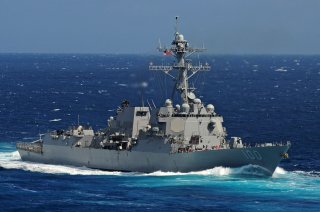The U.S. Navy's AN/SPY-6 Is Going to Revolutionize Naval Warfare
It's thirty-five times as effective as existing radar systems.
Here's What You Need To Remember: The powerful radar could be made more compact and put onto drone boats.
Imagine an armed, surface-patrolling, submarine-hunting large, unmanned surface vessel (USV). Such a warship could operate in a distributed capacity teamed with manned combatants and command centers. The USV could even launch a small fleet of autonomous drone boats to counterattack newly-discovered enemy missile launch facilities at previously undetectable ranges. This kind of attack and warfare is being made possible by a new generation of highly-sensitive, discriminating ship-based radar technology.
Or perhaps a medium-range ballistic missile, small enemy attack drone or anti-ship cruise missile was detected by unmanned vessels at ranges well beyond current line-of-sight radar systems? Manned vessels, Operations Centers, or even ground control stations at safe stand-off distances, would be in position to destroy such enemies with much lower risks. Moreover, the far-away human commanders and sailors would have a greatly expanded time window with which to make crucial attack and defense determinations.
These scenarios, wherein large, medium and small drone boats could autonomously search, find and track enemy threats with unprecedented range and precision, is precisely what the U.S. Navy wants. This is why the service is moving so quickly to integrate and expand a new family of breakthrough, highly-sensitive radar systems called AN/SPY-6. The radars, which bring exponential improvements in detection, tracking and fire-control effectiveness, are already being integrated into Navy destroyers, frigates, carriers and amphibious assault ships. Now, the service is exploring the feasibility of integrating Raytheon’s SPY-6 radars onto drone boats.
“We are looking at unmanned surface vessels and what the Navy might want to scale to meet those types of requirements,” Scott Spence, Director for Naval Radar Systems for Raytheon Missiles & Defense, told The National Interest in an interview.
Yet another interesting developmental possibility, it would seem, could involve decreasing the form factor or size configurations to enable high-powered SPY-6 integration onto smaller surface drones. Such a prospect certainly seems feasible given current technical trends now succeeding with efforts to engineer smaller, more mobile, yet high-power density applications of expeditionary electrical power.
Interestingly, the idea of using power-density innovations, such as those used for SPY-6 radar systems, into drone ships of various sizes is taken up in a 2019 RAND Corp. study called “Advancing Autonomous Systems: An Analysis of Future and Current Technology for Unmanned Maritime Vehicles.”
The RAND study, throughout its discussion of possible hardware and software adjustments to tailor radar systems to unmanned vessels, discusses the merits of radar power density regarding system range. “Increased transmission power increases the power of reflected signals, increasing the likelihood that reflected signals are received by the originator,” the study writes.
The study’s discussion of increased power-density output is consistent with Raytheon’s scientific emphasis, a series of studies and inquiries over the years which ultimately lead to engineering the principal power-density increasing technology for SPY-6, Gallium Nitride (GAN) semiconductors. GAN is, the technology primarily responsible for SPY-6s massive increase in radar range and sensitivity, has much higher power density when compared with previously used Gallium Arsenide modules.
Kris Osborn is the defense editor for the National Interest. Osborn previously served at the Pentagon as a Highly Qualified Expert with the Office of the Assistant Secretary of the Army—Acquisition, Logistics & Technology. Osborn has also worked as an anchor and on-air military specialist at national TV networks. He has appeared as a guest military expert on Fox News, MSNBC, The Military Channel, and The History Channel. He also has a Masters Degree in Comparative Literature from Columbia University.
This piece first appeared last year and is being republished due to reader interest.
Image: Reuters.

